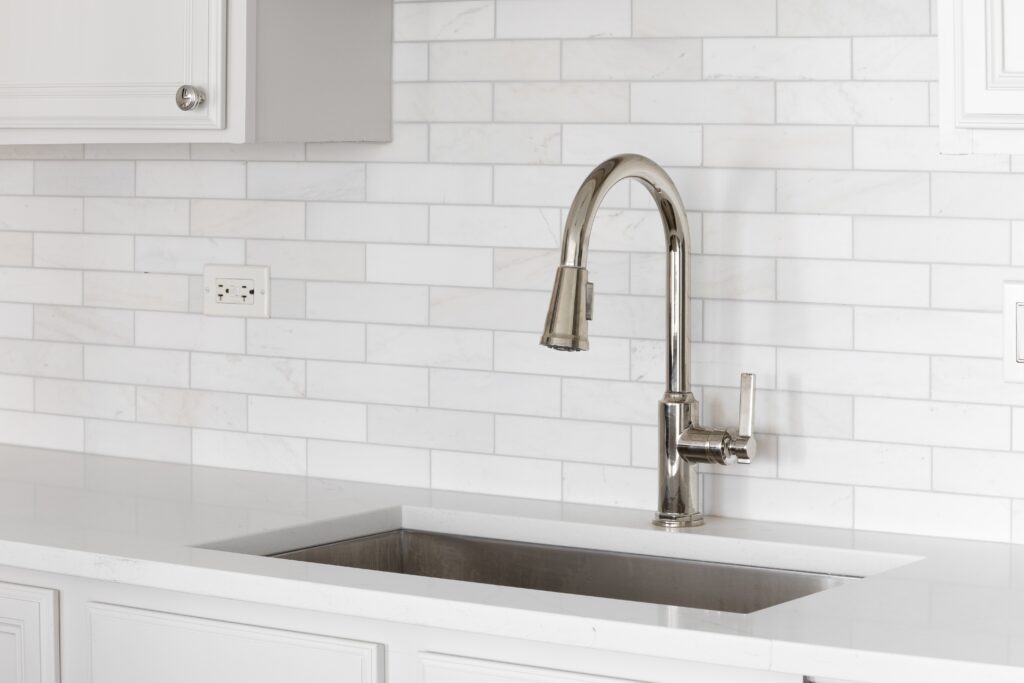Choosing the Right Kitchen Sink for Your Home

*Updated July 21st, 2025
Your kitchen sink is more than just a place to wash dishes—it’s one of the most used features in your kitchen. From meal prep and cleanup to filling pots and watering plants, the right kitchen sink can make your daily routine easier and more efficient. But with so many types of kitchen sinks available, materials, and kitchen sink size options to choose from, how do you pick the best kitchen sink?
Whether you want something sleek and modern, classic and timeless, or ultra-functional with built-in accessories, there’s a type of kitchen sink out there to match your needs.
In this guide, we’ll break down the key factors to consider—like sink type, kitchen sink material, size, and installation—so you can choose a kitchen sink for your home that’s both practical and stylish. Let’s find the best fit for your kitchen!
Types of Kitchen Sinks
Choosing the right kitchen sink isn’t just about looks—it’s about how it fits into your daily routine. Whether you love cooking elaborate meals or just need something simple and functional, the type of kitchen sink you choose can make a big difference.
Let’s break down the most popular sink types.
1. Top-Mount (Drop-In) Sinks
Also known as drop-in kitchen sinks, these are the classic, budget-friendly choice for many kitchens. They’re designed to “drop” into a pre-cut hole in the countertop, with a visible rim that sits on top.
The biggest advantage? Easy kitchen sink installation—you don’t need a pro, and they work with just about any countertop material.
Best for: Homeowners on a budget, DIYers, and those looking for a quick upgrade.
Downside: The exposed edges around the sink can collect crumbs and grime, making cleaning a little trickier.
2. Undermount Sinks
If you love a seamless, modern look, an undermount sink might be the way to go. These sinks are installed underneath the countertop, so there’s no lip or rim to catch debris—just a smooth transition from counter to sink.
Best for: Sleek, modern kitchens; anyone who wants a cleaner, more polished look.
Downside: They’re a little more expensive than drop-in sinks and usually require professional installation since they need to be securely mounted underneath the counter.
3. Farmhouse (Apron-Front) Sinks
Farmhouse sinks (also called apron sinks) are deep, spacious, and have a signature exposed front panel that adds character to any kitchen. They’re perfect for large families or anyone who does a lot of cooking—you can fit big pots and pans and baking sheets with ease.
Best for: Farmhouse, rustic, or traditional kitchens; homeowners who need lots of sink space.
Downside: They require special cabinet modifications and can be pricier than standard sinks. Also, their large size means they take up more counter and storage space.
4. Double-Bowl vs. Single-Bowl Sinks
One of the biggest choices you’ll make is whether to go with a double basin sink or a single kitchen bowl sink.
- Single-Bowl Sinks: These offer one large, uninterrupted space, making them great for washing big pots, pans, and baking sheets. They’re also easier to clean since there’s no divider.
- Double-Bowl Sinks: These are split into two sections, which is great if you like to separate dirty dishes from food prep or need a space for drying.
Best for:
- Single-bowl sinks – Best for people who do a lot of cooking and need extra space.
- Double-bowl sinks – Great for multitaskers who like to soak dishes on one side while prepping on the other.
Downside: Single-bowl sinks mean you lose the ability to separate tasks, while double-bowl sinks reduce the amount of overall space in each section.
5. Integrated Sinks
If you want zero seams, no edges, and effortless cleanup, an integrated sink might be for you. These sinks are made from the same material as your countertop (like quartz, granite, or solid surface), creating a smooth, one-piece design that blends in perfectly.
Best for: Modern, minimalist kitchens; homeowners who want a clean, seamless look.
Downside: Since they’re custom-made, integrated sinks can be more expensive and harder to replace if damaged.
6. Corner & Bar Sinks
If you have a small kitchen or need a secondary sink, corner and bar sinks are a great way to maximize counter space. A corner sink tucks neatly into an unused corner, while a bar sink or prep sink is perfect for entertaining, cocktail stations, or extra food prep.
Best for: Small kitchens, home bars, or kitchens with multiple cooks who need extra prep space.
Downside: These sinks are small and might not work as a primary sink in a busy kitchen.
Choosing the right type of kitchen sink depends on your kitchen layout, cooking habits, and personal style. Whether you want a budget-friendly drop-in sink, a sleek undermount sink option, or a statement-making farmhouse kitchen sink, there’s a perfect match for every home.
Best Sink Materials for Durability and Style
Your kitchen sink takes a lot of daily wear and tear, so choosing the right sink material is just as important as picking the right style. Here’s a quick look at the common types of kitchen sink materials:
Stainless Steel
One of the most popular and budget-friendly kitchen sink materials.
Resists stains and heat, making it great for everyday use.
Downside: Can scratch and show water spots over time.
Granite Composite
Made from a mix of granite stone and resin, these sinks are heat-resistant, scratch-proof, and long-lasting.
Available in various colors and textures to match modern kitchens.
Downside: Heavier than stainless steel, requiring solid countertop support.
Fireclay
A timeless choice with a smooth, glossy finish that resists stains and scratches.
Perfect for farmhouse and classic kitchen designs.
Downside: More expensive than other materials and can chip if hit with heavy objects.
Cast Iron
Coated with glossy enamel, giving it a beautiful, polished look.
Extremely durable and retains heat well.
Downside: Very heavy, requires strong cabinets for support, and enamel can chip if not properly cared for.
Copper & Other Specialty Materials
Copper sinks develop a natural patina over time, adding character to the kitchen.
Naturally antimicrobial, helping to kill bacteria.
Downside: Requires regular maintenance to prevent discoloration and can dent over time.
Choosing the right kitchen sink material depends on your budget, style preference, and daily usage. Stainless steel sinks are a solid all-around choice, while granite, fireclay, and cast iron offer extra durability and style.
Choosing the Right Size and Depth
Kitchen sink size matters! The right fit depends on your kitchen layout, countertop space, and how you use your sink.
Standard Sizes & Depths
Most kitchen sinks are 22 to 33 inches wide, with depths ranging from 6 to 12 inches. Deep kitchen sinks give you more room, while shallower ones are easier to reach into.
How to Choose the Right Fit
Got a small kitchen? A compact sink (22-25 inches) saves counter space. Larger kitchens can handle bigger sinks (30+ inches) for more versatility.
Deep vs. Shallow Sinks
- Deep sinks (10-12 inches) – Great for washing big pots, but can strain your back if you’re bending too much.
- Shallow sinks (6-8 inches) – Easier to use, great for quick cleanups, but may not hold large cookware.
Consider your counter space, kitchen sink size, and daily habits before choosing. If you love to cook, go for a deeper, wider sink. If convenience and easy cleaning are your priority, a shallower sink may be the way to go!
Features to Look for in a Kitchen Sink
Beyond size and style, the right features can make your sink more functional and user-friendly.
Noise Reduction
No one likes a noisy sink! Look for models with soundproofing pads or insulation to reduce the clanking of dishes and running water—especially important for stainless steel sinks.
Drain Placement
Ever notice how some sinks drain better than others? Rear drains free up space underneath for storage, while center drains offer more balanced water flow but may take up cabinet room.
Built-in Accessories
Want to maximize your sink’s usefulness? Sinks with built-in cutting boards, drying racks, and colanders save counter space and make meal prep and cleanup easier.
Matching Your Sink to Your Kitchen Style
Your kitchen sink isn’t just functional—it also plays a big role in your kitchen’s overall look. Choosing the right style, color, and finish can help tie everything together seamlessly.
For a modern kitchen, sleek undermount or integrated sinks in stainless steel or matte black create a clean, minimalist vibe. If your home leans traditional, a classic white fireclay sink or cast iron sinks with elegant curves can complement warm cabinetry and timeless details.
Farmhouse kitchens are all about charm and functionality, making apron sinks (farmhouse sinks) in fireclay or copper a perfect fit. If you love an industrial look, a bold stainless steel kitchen sink or concrete sink adds a raw, edgy feel that pairs well with exposed brick and metal accents.
Color and finish also matter. Stainless steel sinks are versatile and work with almost any kitchen, while matte black, white, or even bold colors can create a unique focal point. Make sure your sink design complements your countertops, cabinetry, and overall style of your kitchen for a cohesive and stylish space.
Installation Considerations
Before choosing your kitchen sink, it’s important to think about kitchen sink installation—whether you’ll go the DIY route or hire a professional, what works best with your countertops, and how your choice impacts plumbing and faucet placement.
If you’re handy and choosing a top-mount (drop-in) sink, you might be able to tackle the installation yourself since these models simply rest on the countertop. However, sinks like undermount sinks, farmhouse sinks, and integrated sinks often require professional installation to ensure a secure fit and proper sealing.
Your countertop material also matters. Undermount sinks work best with solid surfaces like quartz, granite, or butcher block, as they need a strong base for mounting. Top-mount sinks are more versatile and can be installed on laminate, wood, or stone countertops without issues. Integrated sinks are seamless but require custom fabrication, making them a pricier option.
Finally, think about plumbing and kitchen faucet placement. Some sinks come with pre-drilled holes for faucets and accessories, while others require separate holes to be cut into the countertop. If you choose a farmhouse sink, for example, you may need to adjust the plumbing and ensure your faucet height works with the sink’s depth.
Budget Considerations
A kitchen sink is an investment, but that doesn’t mean you have to break the bank. Understanding price ranges, installation costs, and ways to save can help you find a sink within your budget.
How Much Do Kitchen Sinks Cost?
Prices vary widely depending on sink type and material. Here’s a general breakdown:
- Top-Mount (Drop-In) Sinks – $100 to $500 (affordable and easy to install).
- Undermount Sinks – $200 to $1,000 (sleek but requires professional installation).
- Farmhouse (Apron-Front) Sinks – $400 to $2,000+ (high-end style with a bigger price tag).
- Granite Composite Sinks – $300 to $1,500 (durable and stylish but heavier).
- Fireclay & Cast Iron Sinks – $400 to $2,500 (premium materials that last).
- Copper & Specialty Sinks – $600 to $3,000+ (unique, high-maintenance, and statement-worthy).
Additional Costs to Consider
The sink itself isn’t the only expense—you’ll also need to factor in installation, kitchen faucets, and sink accessories.
- Installation Costs: DIY-friendly drop-in sinks save money, while undermount and farmhouse sinks often require professional help ($200 to $500).
- Faucets & Fixtures: A high-quality kitchen faucet can cost anywhere from $75 to $500+, depending on the brand and features (pull-down sprayers, touchless operation, etc.).
- Accessories: Built-in drying racks, soap dispensers, or cutting boards can add another $50 to $200.
Cost-Saving Tips
Looking for ways to get the best value? Here are a few tips:
- Choose a drop-in sink if you want to save on installation costs.
- Compare materials—stainless steel is affordable and durable, while fireclay and copper are more expensive.
- Buy a sink and faucet bundle to save on both.
- Shop during sales or clearance events for discounts on high-end models.
- Consider refurbished or open-box options from reputable retailers.
Balancing cost, durability, and style is key to getting the most out of your kitchen sink investment.
Final Thoughts
Choosing the right kitchen sink comes down to balancing style, function, and budget. From sleek undermount sinks to classic farmhouse sinks, there’s an option to match every type of kitchen and lifestyle. Think about how you use your sink, what material works best for your space, and which features will make daily tasks easier.
No matter your budget, there’s a sink that will elevate your kitchen’s look and efficiency. Take the time to explore different sink styles or consult a kitchen design expert to find the perfect kitchen sink for your home.to explore different styles or consult a kitchen design expert to find the best fit for your home.
Additional Kitchen Resources
- 10 Benefits of Refacing Cabinets
- Guide to Building an Outdoor Kitchen
- 2025 Trending Kitchen Cabinet Colors

Anna has over six years of experience in the home services and journalism industries and serves as the Content Manager at MyHomePros.com, specializing in making complex home improvement topics like HVAC, roofing, and plumbing accessible to all. With a bachelor’s degree in journalism from Auburn University, she excels in crafting localized, comprehensive guides that cater to homeowners’ unique needs. Living on both coasts of the United States has equipped her with a distinctive perspective, fueling her passion for turning any house into a cherished home through informed, personalized decision-making.








